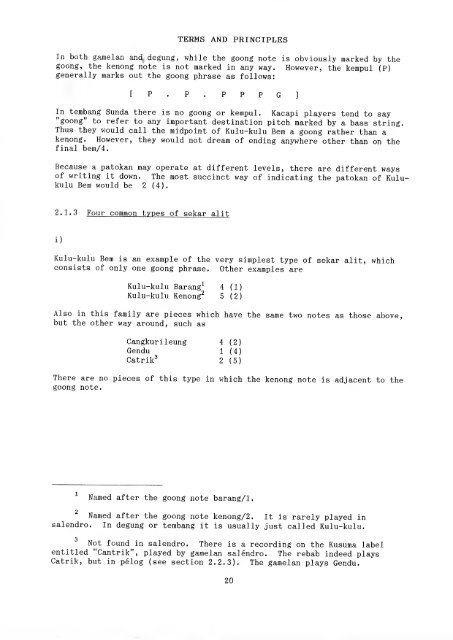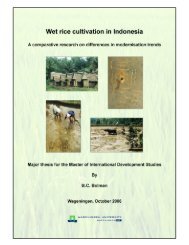Guide to Sundanese Music - Free EBooks Library
Guide to Sundanese Music - Free EBooks Library
Guide to Sundanese Music - Free EBooks Library
Create successful ePaper yourself
Turn your PDF publications into a flip-book with our unique Google optimized e-Paper software.
TERMS AND PRINCIPLES<br />
In both gamelan ani^degung, while the goong note is obviously marked by the<br />
goong, the kenong note is not marked in any way. However, the kempul (?)<br />
generally marks out the goong phrase as follows:<br />
[ P . P . P P P G ]<br />
In tembang Sunda there is no goong or kempul. Kacapi players tend <strong>to</strong> say<br />
"goong" <strong>to</strong> refer <strong>to</strong> any important destination pitch marked by a bass string.<br />
Thus they would call the midpoint of Kulu-kulu Bern a goong rather than a<br />
kenong. However, they would not dream of ending anywhere other than on the<br />
final bem/4.<br />
Because a pa<strong>to</strong>kan may operate at different levels, there are different ways<br />
of writing it down. The most succinct way of indicating the pa<strong>to</strong>kan of Kulukulu<br />
Bern would be 2 (4).<br />
2'1'3 Four common types of sekar alit<br />
i)<br />
Kulu-kulu Bern is an example of the very simplest type of sekar alit, which<br />
consists of only one goong phrase. Other examples are<br />
Kulu-kulu Barang-^ 4 (1)<br />
Kulu-kulu Kenong^ 5 (2)<br />
Also in this family are pieces which have the same two notes as those above,<br />
but the other way around, such as<br />
Cangkurileung








